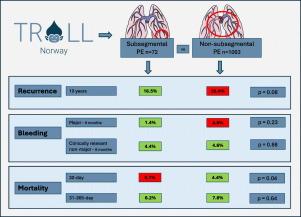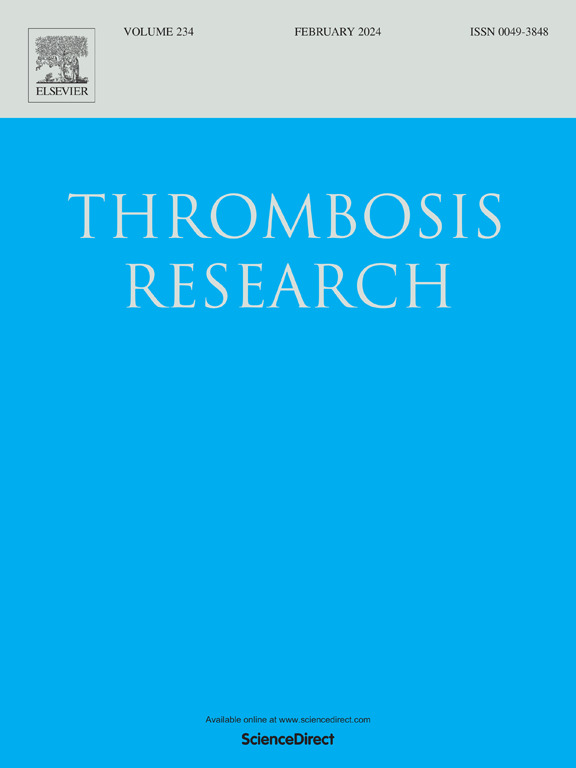Long-term recurrence, bleeding, and mortality after first-time subsegmental pulmonary embolism compared to more proximal pulmonary embolism: Findings from the TROLL registry
IF 3.4
3区 医学
Q1 HEMATOLOGY
引用次数: 0
Abstract
Background
Subsegmental pulmonary embolism (SSPE) refers to clots that exclusively obstruct the subsegmental arteries. Data on long-term recurrence and bleeding risks following SSPE remain limited.
Objectives
To determine the long-term incidence of venous thromboembolism (VTE) recurrence after cessation of anticoagulation in patients with SSPE compared to those with more proximal PE (non-SSPE), to assess major and clinically relevant non-major bleeding (CRNMB), and to evaluate 30-day and 31–365-day all-cause mortality.
Methods
Between January 2005 and May 2020, 1135 cancer-free patients with a first-time computed tomography-verified PE were identified from The Venous Thrombosis Registry in ØstfOLd HospitaL (TROLL), Norway.
Results
Among the 1135 patients, 72 (6.3 %) were diagnosed with SSPE, while 1063 (93.7 %) had more proximal PE. Median age was 70 years (IQR: 58–80), and 51.4 % were women. The 10-year cumulative incidence of VTE recurrence after discontinuation of anticoagulation was 16.5 % (95 % CI: 4.5–35.1) in the SSPE group compared to 28.4 % (95 % CI: 24.5–32.4) in the non-SSPE group (p = 0.08). The 6-month cumulative incidence of major bleeding was 1.4 % (95 % CI, 0.1–6.6) in SSPE cases and 4.6 % (95 % CI: 3.4–5.9) in non-SSPE cases (p = 0.23). The 30-day all-cause mortality rate was 9.7 % (95 % CI: 4.8–19.3) for SSPE and 4.4 % (95 % CI: 3.3–5.8) for non-SSPE (p = 0.04).
Conclusion
While the VTE recurrence rate following SSPE was lower than in non-SSPE cases, it remained high, with 16.5 % recurrence within 10 years. Major bleeding rate was lower for SSPE than non-SSPE (1.4 % vs. 4.6 %, p = 0.23). Unexpectedly, the 30-days mortality rate following SSPE was significantly higher compared to non-SSPE cases.

与近端肺栓塞相比,首次亚节段性肺栓塞后的长期复发、出血和死亡率:来自TROLL注册的研究结果
亚节段性肺栓塞(SSPE)是指单纯阻塞亚节段动脉的血栓。SSPE术后长期复发和出血风险的数据仍然有限。目的:对比近端PE(非SSPE)患者和SSPE患者停止抗凝治疗后静脉血栓栓塞(VTE)复发的长期发生率,评估重大出血和临床相关的非重大出血(CRNMB),并评估30天和31 - 365天的全因死亡率。方法:2005年1月至2020年5月,从挪威ØstfOLd医院(TROLL)的静脉血栓形成登记处发现了1135例首次计算机断层扫描证实的无癌PE患者。结果1135例患者中,72例(6.3%)诊断为SSPE, 1063例(93.7%)诊断为近端PE。中位年龄为70岁(IQR: 58-80), 51.4%为女性。停止抗凝治疗后10年静脉血栓栓塞复发的累积发生率,SSPE组为16.5% (95% CI: 4.5-35.1),而非SSPE组为28.4% (95% CI: 24.5-32.4) (p = 0.08)。SSPE患者6个月累积大出血发生率为1.4% (95% CI: 0.1-6.6),非SSPE患者为4.6% (95% CI: 3.4-5.9) (p = 0.23)。SSPE患者30天全因死亡率为9.7% (95% CI: 4.8-19.3),非SSPE患者为4.4% (95% CI: 3.3-5.8) (p = 0.04)。结论SSPE术后静脉血栓栓塞复发率虽低于非SSPE,但10年内仍有16.5%的复发率。SSPE患者的大出血率低于非SSPE患者(1.4% vs. 4.6%, p = 0.23)。出乎意料的是,与非SSPE病例相比,SSPE后的30天死亡率明显更高。
本文章由计算机程序翻译,如有差异,请以英文原文为准。
求助全文
约1分钟内获得全文
求助全文
来源期刊

Thrombosis research
医学-外周血管病
CiteScore
14.60
自引率
4.00%
发文量
364
审稿时长
31 days
期刊介绍:
Thrombosis Research is an international journal dedicated to the swift dissemination of new information on thrombosis, hemostasis, and vascular biology, aimed at advancing both science and clinical care. The journal publishes peer-reviewed original research, reviews, editorials, opinions, and critiques, covering both basic and clinical studies. Priority is given to research that promises novel approaches in the diagnosis, therapy, prognosis, and prevention of thrombotic and hemorrhagic diseases.
 求助内容:
求助内容: 应助结果提醒方式:
应助结果提醒方式:


